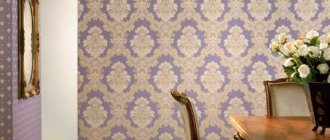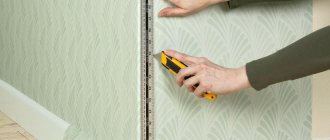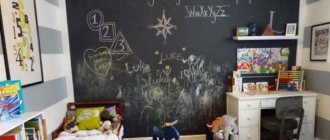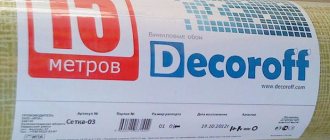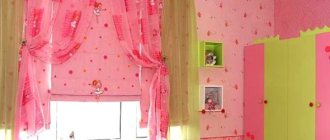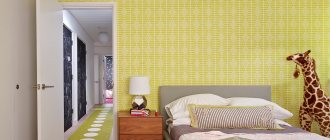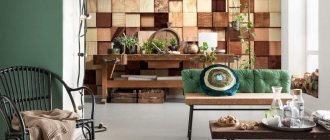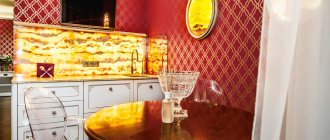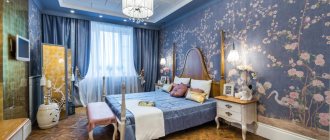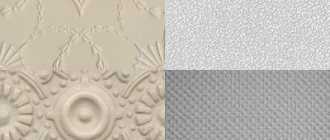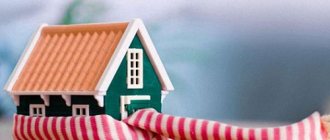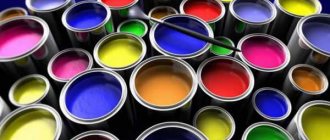Types and characteristics of fabric wallpaper
- Properties and characteristics of textile wallpaper
- Kinds
- Linen fabric
- Jute textile wallpaper
- Silk wallpaper
- Jacquard
- Cotton fabric wallpaper
- Velor
- Textile wallpaper on paper basis
- Felt
- Wallpaper made from synthetic materials
- Non-woven textile wallpaper
- Advantages and disadvantages of fabric wallpaper
- Flaws
- Recommendations for selection
- How to glue - some tips
No matter how surprising it may sound, fabric textile wallpapers marked their appearance long before traditional paper counterparts, and even more so non-woven fabrics. But their use in the form we are already familiar with became popular only a couple of decades ago. Today, textile wallpaper is an essential component of a spectacular and luxurious interior.
Recommendations for selection
When choosing, you should consider the manufacturing method:
- The use of individual threads glued to the base is a simple and, accordingly, cheap production method. Higher quality products contain up to 300 threads. The greater the number of threads used in production, the thicker and, accordingly, the better quality the material.
- Using whole cloth. In this case, textured fabric is glued to the base - the key to impeccable density and strength.
There are also seamless fabric textile wallpapers in rolls; their height varies from 2.8 to 3.1 m, and their length reaches 50 meters.
They allow you to decorate walls without a single joint, creating a monolithic surface without interrupted or broken patterns. In addition, seamless fabrics are additionally treated with Teflon impregnation, which enhances the property of moisture resistance.
As for the base, this is, of course, a matter of taste, but non-woven fabric has a number of advantages over regular paper. Fabric textile wallpaper on a non-woven basis does not deform either during the gluing process or during operation. They are more durable, stronger and more wear-resistant.
If environmental friendliness is one of the main requirements, then preference should be given to products with natural threads. But their price, of course, is higher than the cost of artificial ones.
The manufacturer of fabrics should be of no less interest to the buyer. Today, Italian, Belgian, French and German companies are recognized as leaders in the production of high-quality wallpaper, including: Sangiorgio, Arlin, Calcuta, Zuber and others.
Types of fabric wallpaper
Depending on the manufacturing technology, fabric wallpaper for walls is divided into: silk, linen, felt and jute.
Silk
The canvases, despite their names, are not entirely made of silk. The main material in production is viscose. Thanks to this, the coating has a number of positive properties: it is resistant to direct sunlight, has a long service life and a unique decorative design.
This product is the most expensive of all fabric wallpapers. Silk products are sewn only to order using the individual preferences of the customer.
Linen
They are paper fibers with a combination of flax fibers. This option is the cheapest and most popular of the entire line of products. To increase the service life of the coating, many manufacturers add various compounds that increase the strength and light resistance of the coating.
Felt
They have the most pleasant-to-touch coating. This is explained by the fact that felt fabric is added to the base during production. In its appearance and properties it is very similar to velor.
Jute
They are characterized by being made from wood fiber. Jute wallpaper on a fabric base goes well with a rustic and “natural” style in the interior. Among the technical characteristics, they include: density and strength, ease of gluing and the ability to visually hide irregularities.
Types of textile wallpaper
There are many color variations that will suit any interior style and apartment design. For their production, high-quality natural materials are used: linen, felt, silk, jute, etc., as well as their synthetic analogues.
Let's look at the information about the material in more detail:
- Wallpaper made of jute - such wallpaper is quite durable, and also well masks uneven surfaces and flaws in the walls, has a pronounced texture, tolerates dry cleaning well, and also does not fade when exposed to sunlight.
- Velor wallpaper - suitable for rooms with a minimum amount of dust, made using a specific technology, which consists of many complex processes, which makes them more expensive.
- Silk wallpapers are actually viscose with a small addition of silk, since if they were completely silk, their cost would be incredible. They can be made individually to suit the wishes of each customer.
- Felt wallpaper has a fairly attractive appearance and is sold not in rolls, but by the meter. They tolerate wet cleaning well, even with the help of detergents, but those that are not aggressive to the material, for example, should not contain bleaching agents. They have excellent sound insulation qualities and will also help keep the room warm. When choosing this type of wallpaper, find out whether they are made from natural raw materials or from synthetic analogues. Their price should depend on this.
- Wallpaper made from linen has an aesthetic appearance that will please the eyes, does not fade under the influence of sunlight, tolerates dry cleaning well, and wet cleaning should never be used on it.
Depending on the basis on which such wallpaper is made, 3 types can be distinguished:
- On a non-woven basis - they are distinguished by the speed of gluing, but unlike others, they require that they be pre-saturated with glue.
- On a synthetic basis - the peculiarity of this type is that soft foam rubber is used as a base, which also has thermal insulation properties.
- On a paper basis - it is a little more difficult to stick to walls than those made on a non-woven basis, but they are the most environmentally friendly.
Advantages and disadvantages of textile wallpaper
It’s not difficult to understand the positive side of textile wallpaper - it’s a unique look, the naturalness of the materials, a respectable appearance, a long service life, and other advantages of the fabric used for their manufacture. But, as they say, you are greeted by your clothes, but seen off by your mind; it is not enough to know the advantages - in order to form the right impression of the material, you also need to become familiar with the shortcomings, of which textile wallpaper has many. These include the following disadvantages.
- The cost is too high - a couple of orders of magnitude higher than the most expensive ordinary wallpaper.
- They do not tolerate moisture. On some textile wallpapers, water stains remain permanent.
- Highly susceptible to dust. If ordinary wallpaper in this regard does not need to be looked after at all, then textiles will have to be vacuumed regularly. There are, of course, antistatic textile wallpapers, but they are even more expensive than regular material of this type.
- Complex gluing technology - a drop of glue, absorbed into the fabric, remains there almost forever in the form of an unsightly stain. Even the special glue recommended by the manufacturer does not help - care and caution are needed here!
In most cases, the disadvantages of these wallpapers outweigh their advantages, and people who have already encountered such wallpapers try not to use them in the future. The most they dare to do is make small decorative inserts. Also, this type of wallpaper is preferred by wealthy people - they don’t care how much they cost, and by and large, it is not they who take care of them, but hired workers. In general, you should think carefully about their use and talk to people who have already dealt with these wallpapers.
Pros and cons of textile wallpaper
Is it even worth choosing such an exotic finishing material as textile wallpaper for your home? There are several arguments for and against.
The advantages are probably more obvious: visual appeal, status, originality. It should also be noted that most of them are environmentally friendly. Increased sound insulation is also important.
But the disadvantages are not immediately clear, so don’t rush to the store. Firstly, you need to be prepared for the fact that in almost 100 percent of cases when gluing textile wallpaper, the joints will be noticeable. All due to the heterogeneity of the color of the fibers.
Secondly, decorating a wall with high-quality fabric wallpaper is not an easy task, even for a pro. You will need to look for an experienced and reliable master. This point also includes the high cost of the wallpaper itself.
Thirdly, textile wallpaper does not perform very well in operation. They tend to collect dust, and they can only be cleaned with a dry cloth - naturally, perfect cleanliness cannot be achieved. Well, any stain on the fabric is still noticeable.
You can still look for shortcomings, but it is already clear that you need to choose textile wallpaper only in special cases, and in which cases - read below.
When to use fabric wallpaper for walls
This type of coating is suitable for design in bedrooms, children's rooms, offices, living rooms and dining rooms.
It is worth giving preference to this particular finishing coating if the interior predisposes to an atmosphere of luxury or, on the contrary, maximum eco-friendly orientation. Also an ideal solution when it is necessary to hide uneven walls - textured felt, jute or velor wallpaper.
Another important factor is environmental friendliness, for example, for children's rooms it is better to choose natural materials.
What drawing?
Traditional.
Fabric wallpaper is a classic, and the patterns on it are traditional. These are floral patterns, rosettes, medallions, simple “geometry” (stripes, squares), and plain coverings.
- 1 of 4
On the picture:
Collections that include wallpapers of different textures and colors, which can be combined to suit your own taste, will help diversify your interior.
A few words about gluing
The characteristic points for gluing walls with fabric-based wallpaper are as follows:
- For all types of fabric wall coverings, binders suitable for heavy wallpaper are used;
- Fabric sheets soaked in glue are applied to the wall using a special brush with soft and long bristles;
- In the case of gluing felt canvases, the glue is applied only to the walls, without the need to apply it to the finishing material itself;
- All textile coverings are glued together joint to joint;
- Try to avoid creases when gluing linen and silk wallpaper.
In many characteristics and nuances, gluing fabric wallpaper is no different from covering walls with paper or non-woven fabric.
The process of gluing with fabric is carried out according to standard technology, which involves leveling the base, applying protective compounds, marking the walls, cutting the canvas, diluting the glue and, in fact, gluing itself.
Thus, applying fabric covering to walls is quite easy. What is important is to precisely compress the canvas and be careful.
Textile wallpaper: types, how to choose and hang
Since ancient times, people have tried to make their homes beautiful. Animal skins were previously used to decorate walls, ceilings, floors and windows. Ancient people hung them on the walls, laid them on the floor, and hung the entrances to their caves with skins. Thus, the houses of primitive people became warmer and more comfortable. Over time, humanity learned to make fabric, which modern people began to use to decorate their homes.
Walls draped with fabric were more often found in the mansions of noble people and palaces. With the onset of the mid-18th century, for the first time, paper began to be used for pasting walls and ceilings. Today progress has stepped far into the future. Nowadays, wallpaper made from various materials, including fabric, is used to decorate walls and ceilings.
The usual idea of decorating the walls of a living room, bedroom, and kitchen can easily be changed by textile wallpaper .
In this article we will talk specifically about textile wallpapers, their varieties, advantages and disadvantages, methods of sticking, and caring for them.
Textile wallpaper is intended for interior decoration of apartments, offices, and cottages. They allow you to create a truly royal interior, dressing the apartment rooms in a beautiful “dress”. This rolled material consists of several layers, the top one being fabric. The first name for textile wallpaper was “damask”. They got it thanks to German dense wool or silk fabric, which was used for interior decoration and upholstery in the old days.
The basis of textile wallpaper can be paper, non-woven or foam rubber. Fabric wallpaper on a non-woven basis allows you to simplify wallpapering; they are unpretentious and have an increased service life. During the wallpaper manufacturing process, decorative textiles are applied or glued to the base. In its finished form, it is the fabric that gives textile wallpaper its aesthetic qualities.
Types of textile wallpaper
Textile wallpapers are divided into 2 types according to the production method. Based on threads and solid fabric. In the first option, threads made of natural material are glued onto the base, one on top of the other, their number can be from 10 to 300 units. The more threads, the thicker the layer of wallpaper. The cost of this type of wallpaper is cheaper than solid wallpaper.
The second type consists of paper or non-woven fabric followed by gluing a solid textured fabric onto them. This type is considered more durable and expensive.
Today a type of textile wallpaper is presented on a synthetic basis, which is foam rubber. The textile fabric is glued to the foam rubber, which increases the sound and heat insulation of the rooms. After gluing the canvas, the wall feels soft to the touch, but at the same time elastic. This type is usually pasted in bedrooms or in a home office. Roll size: length 7.7 m x width 0.9 m.
- Linen wallpaper consists of paper and natural flax threads combined by lamination. It is worth noting the main advantages of both flaxseeds - ultraviolet resistance, noise and heat insulation. Dimensions: length 10 – 50 m x width 53 – 80 cm.
Felt wallpaper is made from paper and then coated with foamed polypropylene or felt fabric. They can feel like velor to the touch. Able to mask small unevenness in walls. Dimensions: length 30 – 50 cm x width 0.9 m – 1 m.
Not everyone can afford fabric wallpaper made from natural silk. Therefore, for the manufacture of silk wallpaper, viscose with the addition of natural silk is used. Thus they are more accessible. This type can have a pattern; they can also be painted. Their length is 9 m x width 0.9 m.
Jute wallpaper is made from paper and jute. Jute is an annual plant from the linden family. The plant grows in North America and Africa. Like other types of textile wallpaper , this type has positive characteristics: it hides surface imperfections, insulates and soundsproofs, is wear-resistant, resistant to sunlight, and its most important advantage is its beautiful appearance. Dimensions: length 10 m x width 0.9 m.
Selection of textile wallpapers
The fabric wallpaper market is represented by a huge assortment. When choosing textile wallpaper, you can find any variations in color and range, texture and pattern. In addition, if you want, you can order any design from the manufacturer. In fashion collections, you can choose aged textures or shining threads that hit the eyes with their shine.
The price of textile wallpaper depends on several factors: manufacturer, type of wallpaper, color and texture, environmental friendliness. Today, manufacturers of textile wallpaper from Italy, Belgium, and Germany are popular. The average cost of a roll is 1500 – 2000 rubles.
Textile wallpaper allows you to cover walls without seams. Seamless wallpaper is used for this. Their dimensions are: 2.8-3.1 m x length up to 50 m. The room is covered with a solid canvas, in which slits are made for door and window openings.
Some wallpapers may be coated with Teflon impregnation, which does not allow them to absorb water. A drop of water that gets on the wallpaper quickly rolls off the surface.
Expert recommendations for wallpapering and care
In order not to spoil the expensive finishing material and enjoy all the advantages of seamless wallpaper, you need to follow several expert recommendations for gluing textile fabric and caring for it. First of all, it is necessary that the walls and corners are perfectly smooth, and then it will be possible to achieve symmetry of the pattern. It is recommended to start gluing from the far corner or the place where high furniture will be installed (wall, closet, etc.). To smooth the canvas on the wall surface, use a rubber roller; to work in corners, use a flexible silicone wallpaper spatula. If bubbles form, you can use a hot iron set to the “cotton” setting to smooth it out.
Smooth out the wallpaper with a special flexible spatula
For long-term service of seamless wallpaper, it is necessary to treat it with care and provide proper and constant care. By the way, caring for this finishing material is quite easy, since manufacturers treat the front part of the wallpaper with special antistatic compounds that create reliable protection against dust and dirt. However, this type of finish should not be wet cleaned and detergents should not be used. You can clean dirt with a vacuum cleaner or a slightly damp cloth.
Textile seamless wallpaper accepts dry cleaning only
Textile wallpaper: properties and characteristics
This material belongs to the classic two-layer combinations. The basis, most often, is thick paper. The finishing coating is fabric, in the form of linen or fibers. Despite the vast variety of design options, all textile wallpapers have similar properties and characteristics .
- They have a high safety record for human health. Fabric coverings are environmentally friendly, consisting of natural fabrics or their combinations with artificial fibers. Textile wallpaper is non-toxic and non-allergenic. They can be used quite easily to decorate a child’s room.
- This type of wallpaper is not only beautiful and aesthetically pleasing, but has a lot of useful practical properties. For example, retaining heat in a room. You shouldn’t think that textile wallpaper will keep you warm in the winter cold, but they are able to accumulate heat when it is in excess and release it back when it is in short supply. This valuable property can manifest itself differently in wallpaper made from different materials. For example, in cotton and plant fibers it is more pronounced, in synthetic fabrics it is less pronounced.
- Textile wallpapers are natural sound insulators, therefore they provide additional noise protection from external irritants. In addition, they perform the opposite function, reducing the intensity of noise waves that come from inside the room.
- Those who like a single interior space will definitely appreciate textile wallpaper. After all, when using them, the connecting seams are practically invisible, except upon very careful inspection.
- But textiles have not only positive qualities. Wallpaper made from this material quickly gets dirty as it attracts dust. They absorb moisture, are unstable to water and steam, and also have an inconvenient ability to adsorb odors. For these reasons, the use of textile wallpaper has some limitations. They are not recommended for use in kitchens, bathrooms and utility rooms that are poorly ventilated.
- Many people also include the price as a disadvantage of textile wallpaper. It varies depending on what fabric is used, who the manufacturer is and where the wallpaper is made. But their cost is rarely below 1000 rubles per roll, and options made from expensive or completely natural fabrics are much more expensive.
